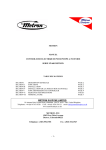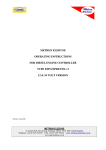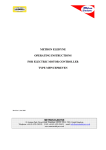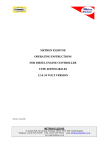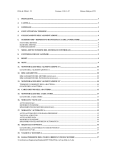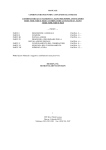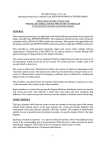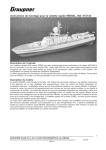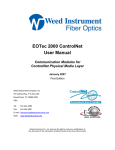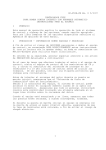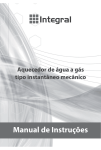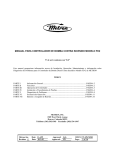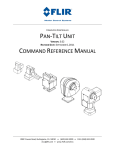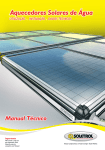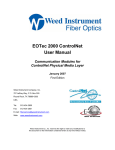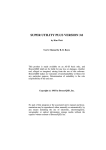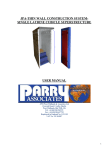Download manual electric fire pump controllers metron series mv600
Transcript
MANUAL ELECTRIC FIRE PUMP CONTROLLERS METRON SERIES MV600 TABLE OF CONTENTS PART I PART II PART III PART IV PART V PART VI PART VII GENERAL DESCRIPTION ................................................................................... PAGE 2 FUNCTIONS .................................................................................................... PAGE 2 INSTALLATION.................................................................................................... PAGE 3 INITIAL INSTALLATION START-UP ................................................................ PAGE 3 OPERATION OF CONTROLLER......................................................................... PAGE 4 SEQUENCE OF OPERATION .............................................................................. PAGE 5 NOMENCLATURE................................................................................................ PAGE 6 METRON ELEDYNE LIMITED 18 Autumn Park, Dysart Road, Grantham, LINCS. NG31 7DD. United Kingdom Telephone: +44 (0) 1476 516120 FAX: +44 (0) 1476 516121 email: [email protected] www.metroneledyne.co.uk METRON, INC. 1505 West Third Avenue Denver, Colorado 80223 Telephone: (303) 592-1903 -1- Fax: (303) 534-1947 PART I: GENERAL DESCRIPTION The basic function of the Fire Pump Controller is to start the pump motor to maintain the water system pressure. The MV600 Controller will automatically start the pump motor upon drop in pressure in the water main or from a number of other demand signals. This unit can be started automatically, manually or by remote manual means but cannot be stopped remotely. The controller can be set to stop automatically or require manual stop after an automatic start. PART II: FUNCTIONS A. Automatic Starting From: 1. Drop in water line pressure. 2. Deluge valve operation, Option D. 3. Supervisory power failure, Option P. B. Alarm and Signals: 1. Remote indication of pump operation: One (1) set of normally open (N.O.) and normally closed (N.C.) contacts located in the controller operate when the pump is running. 2. Loss of power to the controller: One (1) Single Pole Double Throw (SPDT) contact located in the controller operates for loss of power, loss of one phase, or loss of control power. 3. Phase reversal of power to controller: One (1) SPDT contact located in the controller operates for phase reversal of power to the controller. 4. Motor Overload: One (1) SPDT contact located in the controller operates when the motor current exceeds 125% of full load. 5. Power ON pilot light: his light is on when the contactor is racked in, indicating that power is available and the controller is set for operation. 6. Phase reversal pilot light: This pilot light is on whenever there is a phase reversal of the power to the controller. 7. Motor Tripped pilot light: This pilot light is on when the Overcurrent Monitor has tripped and deactivated the contactor coil circuit. 8. Engine Lockout (Option E): When an engine drive system is used as a backup a normally open auxiliary contact on the motor contactor is provided to prevent the engine from starting if the electric motor is running. 9. Electric Motor Lockout (Option M): The electric motor lockout is generally used in conjunction with engine lockout above. If the engine is running due to a power outage, or other reasons, the electric motor can be locked out until the engine is stopped. C. Sequential Starting: This feature is provided to allow a time delay between pressure drop and actual starting of the motor which guards against nuisance starts. It also allows for multiple motors to start at delayed intervals to reduce inrush surges on the electrical line. D. Principal Components of Controller: 1. Drawout/Disconnect 2. Fuse Rack 3. Contactor 4. Pressure Switch The incoming line is connected directly to the high voltage buss. From there, the power is fed to the line side of the motor contactor (1MC) via the stab connectors. (This is accomplished by the Drawout feature) The contactor is operated either manually or automatically to start the motor. -2- PART III: INSTALLATION The high voltage fire pump controller has been assembled and wired at the factory with the highest workmanship standards. All wiring and functions have been thoroughly tested to ensure correct operation when properly installed. Before operating the controller, perform the Initial Installation Start-Up Procedure, Part IV. The cubicle should be well grounded according to local standards (a ground buss is provided in the top of the cubicle). Make sure that all applicable external control wires are connected to appropriate terminals as shown on the schematic. Failure to make the proper connections will cause the controller to malfunction. After installation has been completed, perform the Initial Installation Start-Up Procedure, Part IV before operating the controller. Note: It is recommended that the Toshiba DV drawout unit user manual be read before proceeding. PART IV: INITIAL INSTALLATION START-UP PROCEDURE A. General: All but the final test can be made with the Test-Off-Run switch in the test position, and the motor contactor (1MC) in the disengaged/test position. This will eliminate the need for starting and stopping the motor several times during testing. Refer to Part VII for nomenclature of all controls. Refer to schematic for location of contacts for remote alarms. The controls and their functions are as follows: B. 1. Drawout/Disconnect: This assembly is connected in the circuit between the line and the motor contactor. Its function is to connect/disconnect the line voltage to/from the contactor. 2. Fuses: The fuses are electrically located between the motor contactor and the line voltage stab connectors. They are physically located on top of the motor contactor. 3. Emergency Start Lever (FOR EMERGENCY USE ONLY): This mechanical control is used to start the fire pump in case of any malfunction within the control circuits. When operated, ensure that the lever is moved upward to its highest position in one motion with no hesitation. If lever does not latch into the ON position, return it to the bottom of its travel and try again. 4. Start Button: This push button starts the pump motor by exciting the contactor coil so that it closes. 5. Stop Button: This control is to stop the pump motor by opening the contactor coil circuit, thereby, disconnecting the current to the pump motor. MV600 Combined Manual Automatic: 1. Be sure the isolation/contactor section door is closed and latched. 2. Operate the Drawout/Disconnect lever to its lowest position. The release lever must be operated in order to do this. 3. Turn Test-Off-Run selector switch to the "Off" position. 4. The three prong recessed male receptacle located in the low voltage control section will have to be energized from a reliable 120 VAC power source of the proper polarity. -3- C. 5. Turn the Test-Off-Run switch to Test position. Note: The phase reversal and power monitoring functions are inoperative when in the Test mode. 6. Push the start button; the motor contactor should close. 7. Push the stop button; the motor contactor should open. 8. Drop water pressure at water inlet to controller so pressure switch will close. After a short delay determined by timer 3TR, the motor contactor should close. Allow water pressure to return to normal. If controller is set for automatic stop (jumper between C&D removed), set the running period timer (1TR) for a minimum of 10 minutes. Motor contactor should open after this time period. If the controller is set for manual stop (jumper between C&D installed), push the stop button; motor contactor should open. 9. For controllers supplied with Option D, repeat Step 8 except momentarily open deluge valve switch instead of dropping pressure to close pressure switch. Sequential Starting: The sequential start timers provide a time delay between the pressure switch contacts closing and the motor contactor closing. Set the sequential start timers to approximately ten (10) second intervals if multiple fire pump controllers are involved. If only one fire pump controller is involved, set the timer to a minimum of ten (10) seconds. Perform initial start-up procedure for appropriate controller and check for sequential start timing on Automatic starts. PART V: OPERATION OF CONTROLLER After the installation and test procedure are completed, the unit is ready for normal operation. A. Turn the Test-Off-Run switch to "Off". Disconnect the external 120VAC power source which was connected in Part IV. B. Close the Drawout/Disconnect by moving the Drawout/Disconnect lever to its highest position. C. Turn Test-Off-Run switch to the Run position. D. Manual Controller: Controller is now ready for manual operation. The controller is started by pushing the start button. If for some reason the motor fails to start when the start button is pushed, the Emergency Start lever may be moved to the "On" position. THIS LEVER IS FOR EMERGENCY USE ONLY. E. Automatic Controller: The controller is now ready for Automatic operation. Timing relay 3TR should be set for ten (10) seconds minimum. If multiple fire pump controllers are involved, the timing relays (3TR) should be set for ten (10) second intervals between starting of individual fire pumps (Refer to Part IV, Item C). Local requirements may dictate different time settings. For controllers set for Automatic stop, set the running period timer (1TR) for a minimum of ten (10) minutes. To activate the automatic stop feature, the jumper between Terminals C and D must be removed. F. Emergency Manual Operation: Emergency manual operation is provided in case of failure of control circuitry. THIS LEVER IS FOR EMERGENCY USE ONLY. To stop the unit after it has been started with the emergency start lever, press and hold the stop push button to open the motor contact (if possible) and move the emergency start lever to the "Off" position. -4- PART VI: SEQUENCE OF OPERATION A. Introduction: The explanation of the sequence of operation will start with the assumption that the controller has been properly installed, all external connections have been made, and the Drawout/Disconnect is in the engaged (closed) position. In other words, the controller is operational. The power available pilot light should be on. B. Manual Operation: For manual operation, there is a start push button on the controller and terminals for an optional remote start switch. These switches have normally open contacts which close to energize 3CR. 3CR locks in on its own N.O. contact and stays energized until the stop push button is depressed. A N.O. contact of 3CR closes the circuit to the motor contactor to start the motor. C. Automatic Operation/(Pressure Switch): On drop of water pressure, the N.C. contact in the pressure switch closes energizing the coil of 3TR. At the end of the timer period, a N.O. contact of 3TR closes energizing the motor contactor. D. Automatic Operation/(Deluge Valve - Option D): The deluge valve switch is a N.C. switch. When it opens, 7CR is de-energized. The N.C. contacts of 7CR in the automatic circuit close and energize 3TR. The remaining sequence to start and stop the motor is the same as automatic operation with the pressure switch closing. E. Remote/Pump Running Signal: One (1) N.O. and one N.C. contact is available for remote indication that the pump is running. F. Remote/Loss of Power, Phase Reversal: One (1) SPDT contact is available for remote indication of loss of line power or phase reversal. G. Motor Overload: One (1) SPDT contact is available for remote indication that the motor current has exceeded 125% of full load. H. Engine Lockout/(Option E): A N.O. auxiliary contact on the motor contactor is provided to prevent an engine type controller from starting if the electric motor is running. Circuitry for this is provided in engine controllers supplied with Option E. I. Overcurrent Monitor (1OCM): The overcurrent monitor (1OCM) senses the motor current through a set of current transformers (CTs) in the controller. When the motor current exceeds 125% of normal a yellow LED illuminates on the monitor and a set of dry contacts change state. When the motor current exceeds 300% the monitor begins timing based on how much the current exceeds 300% of normal and a red LED begins flashing. The greater the current the shorter the time period such that at 600% of normal the monitor activates in approximately 14 seconds. When the monitor activates (at the end of timing), a set of normally closed contacts open de-energizing the contactor coil circuit. In addition the Motor Tripped pilot light is illuminated. To reset the overcurrent monitor in order to restart the controller, depress the reset pushbutton on the controller door or press the reset pushbutton in the lower left corner of the 1OCM. J. Current & Voltage Display (1CVD): The 1CVD display unit provides a continuous display of controller voltage and motor current. A Select pushbutton is provided to toggle the display between three phase voltage readings and three phase current readings. Also, if the Select pushbutton is held for 3 seconds the unit will display the highest motor current since the last reset. This value can be reset by holding the Select button for 15 seconds. This feature is especially useful for monitoring the motor starting current. The unit, in conjunction with the 1OCM will display the value of motor current that caused the 1OCM to trip. After the 1OCM goes into a -5- locked rotor tripped condition, the display module will display the last current that caused the 1OCM to trip until the reset pushbutton is pressed. K. Electric Motor Lockout/(Option M): Terminals are available to connect to an external switch to lockout the electric motor. This may be necessary to prevent the motor from starting when the engine is running or when a low suction cutoff panel is used, etc. The external switch will close to energize 9CR. A N.C. contact of 9CR will break the circuit to 3TR and keep the motor from starting. With the electric motor lockout feature energized, it is still possible to start the motor manually. L. Power Failure Start/(Option P): On loss of reliable source of 120 VAC, relay 8CR will be deenergized. The N.C. contact of 8CR will close and start the electric motor in the same manner as for drop in water pressure described in Section C. PART VII: NOMENCLATURE 3CR 5CR 7CR 8CR 9CR Manual Start Relay Transformer Secondary Power Available Relay Deluge Start Relay (Option D) Power Failure Start Relay (Option P) Motor Lockout Relay (Option M) 1TR 3TR Run Period Timer Sequential Start Timer 1MC Motor Run Contactor 1MCA Motor Contactor Auxiliary Contacts 1PB 2PB Stop Switch Start Switch 1PS 1CPT 2CPT Pressure Switch Control Power Transformer Control Power Transformer 1PM 1OCM 1CVD Power Monitor Overcurrent Monitor Current/Voltage Display Module 1CT 2CT 3CT Current Transformer Current Transformer Current Transformer 1PR 2PR Phase Loss Relay Phase Reversal Relay -6-






